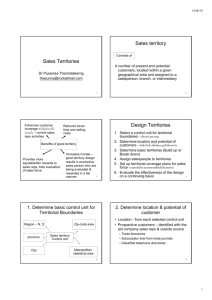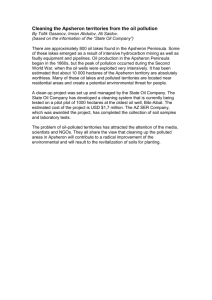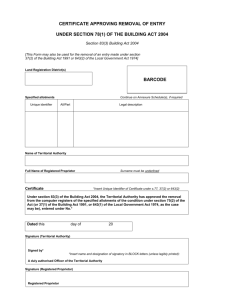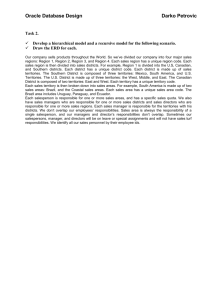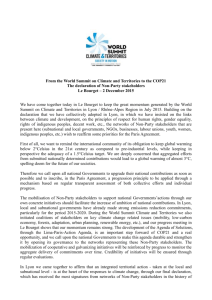a montane hummingbird territorial system in oaxaca, mexico
advertisement
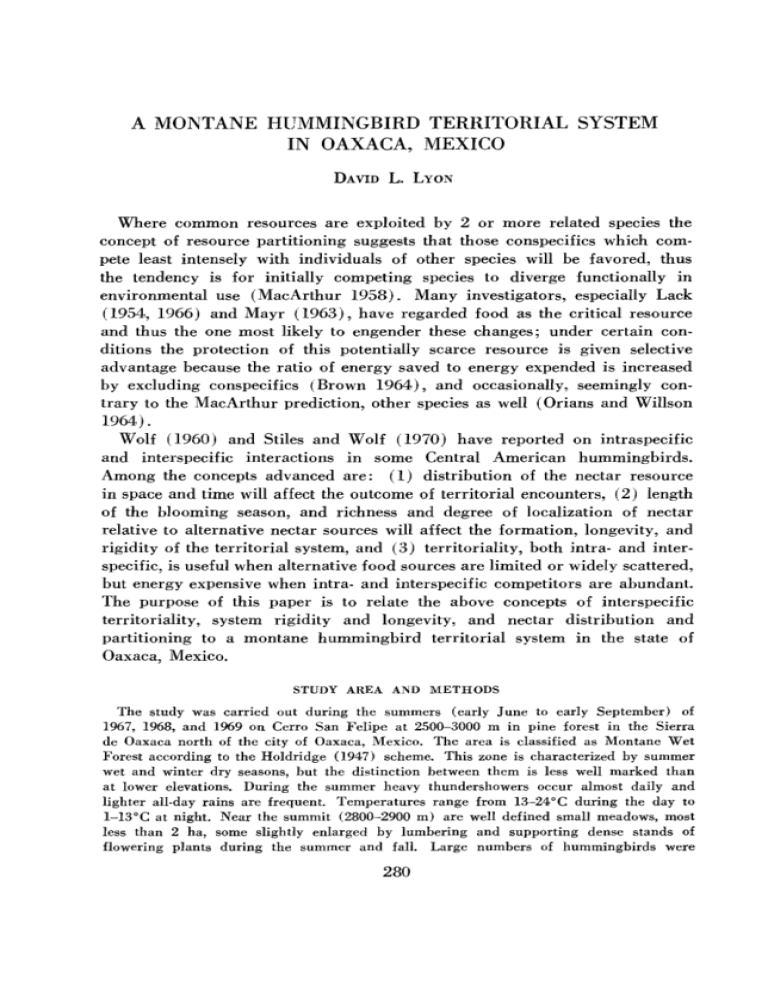
A MONTANE HUMMINGBIRD IN OAXACA, DAVID L. TERRITORIAL MEXICO SYSTEM LYON Where common resources are exploited by 2 or more related species the concept of resource partitioning suggests that those conspecifics which com- pete least intensely with individuals the tendency is for initially environmental use (MacArthur of other species will be favored, thus competing species to diverge functionally 1958). Many in investigators, especially Lack (1954, 1966) and Mayr (1963), have regarded food as the critical resource and thus the one most likely to engender these changes; under certain conditions the protection of this potentially scarce resource is given selective advantage because the ratio of energy saved to energy expended is increased by excluding conspecifics (Brown trary to the MacArthur 1964)) and occasionally, seemingly con- prediction, other species as well (Orians and Willson 1964). Wolf (1960) and Stiles and Wolf and interspecific interactions in (1970) h ave reported on intraspecific some Central (1) American hummingbirds. distribution of the nectar resource in space and time will affect the outcome of territorial encounters, (2) length Among the concepts advanced are: of the blooming season, and richness and degree of localization of nectar relative to alternative nectar sources will affect the formation, longevity, and rigidity of the territorial system, and (3) territoriality, both intra- and interspecific, is useful when alternative food sources are limited or widely scattered, but energy expensive when intra- and interspecific competitors are abundant. The purpose of this paper is to relate the above concepts of interspecific territoriality, partitioning system rigidity and longevity, to a montane hummingbird and nectar distribution territorial and system in the state of Oaxaca, Mexico. STUDY AREA AND METHODS The study was carried out during the summers (early June to early September) of 1967, 1968, and 1969 on Cerro San Felipe at 2500-3000 m in pine forest in the Sierra de Oaxaca north of the city of Oaxaca, Mexico. The area is classified as Montane Wet Forest according to the Holdridge (1947) scheme. This zone is characterized by summer wet and winter dry seasons, but the distinction between them is less well marked than at lower elevations. During the summer heavy thundershowers occur almost daily and lighter all-day rains are frequent. Temperatures range from 13-24°C during the day to l-13°C at night. Near the summit (2800-2900 m) are well defined small meadows, most less than 2 ha, some slightly enlarged by lumbering and supporting dense stands of flowering plants during the summer and fall. Large numbers of hummingbirds were 280 Lyon * HUMMINGBIRD TERRITORIAL 281 SYSTEM Woodland DC Woodland DC Woodland DC ii? Woodland DC w --., I 0 50 METERS 100 ,___L.._ ~Woodland x \\ \ * FIG. 1. Map of main meadow of study area indicating general vegetation pattern and flower abundance. LC = light canopy; DC = dense canopy. MF = many flowers; FF = few flowers: NF = no flowers. attracted by the rich floral food source and it was in these meadows that most observations were made (Fig. 1). In most meadows, trees were absent or widely scattered, but others resembled open parkland dominated by 20-25 m pines (Pinus montezumae, P. pseudostrobm, and P. m&s) and with a sparse understory of alder (Alnus sp.), oak (Quercus spp.) and madrone (Arbutus spp.). Small streams were present in some meadows, and willows (S&x sp.) and elderberry (Sambucus sp.) occurred along them locally. Border between meadow and dense forest was usually abrupt. Hummingbirds of all species were occasionally encountered within forest, but with the exception of White-ears (Hylocharis leucotis) most species were primarily restricted to meadows or meadow-forest ecotone. Birds were captured for markin g in 10 m, 4.shelf, nylon mist nets. In 1967 4 nets and THE 282 WILSON - Vol. 88, No. 2, June 1976 BULLETIN in 1968 and 1969 8 nets were in continual operation. Nets were placed around meadow edges where territorial chases were especially frequent. Locations were usually changed twice weekly. Various colors of “Pla” enamel chosen for high visibility were used to mark individual birds. Unmarked individuals were identified by distinctive physical or behavioral features, but near the end of the study period in all years most territorial birds were marked. Territory boundaries were determined by noting consistency of perch occupancy, and the frequency and location of chases and displays. Area of territories was determined by planimeter measurement from hand-drawn scale maps. During periods of observation of feeding activity various measurements of movement, location, and positioning of birds at plants and blossoms were obtained with a stopwatch and recorded on a tape recorder. RESULTS Hummingbirds in the territorial were important in the territorial (Lampornis AND DISCUSSION system--Six clernenciae) , Amethyst-throated genes fulgens) , White-eared, Violet-eared bee (Atthis heloisa) (Table 1). species of hummingbirds system on Cerro San Felipe: Blue-throated (L. umethystinus) , Rivoli’s (Colibri (Eu- thalassinus) , and Bumble- White-ears were probably the only abundant year-round residents in the study area judged by the general scarcity in early June of other species prior to the flowering season, although Blue-throats and Bumblebees may have been resident in small numbers. With the exception of Bumblebees which were relatively abundant in early June but rare the rest of the summer, other species were first observed in the study area in late May to mid-June and increased steadily in number until populations stabilized in July-August. Blue-throats and White-ears were the most abundant species in meadow areas as determined by general observation and the number captured in mist nets over the 3-summer period (Table 1). All species were observed in about the same proportions Rivoli’s which was common in 1967 and 1968, but uncommon in 1969. Nectar resource.-Meadows on Cerro San Felipe supported a profusion of flowering plants during June-September, hummingbird-pollinated Rigidella each year with the exception of orthantha plants. (Iridaceae) a large proportion Penstemon kunthii (Fig. 2) of which were (Scrophulariaceae) and were the most abundant and the major sources of nectar for most hummingbirds. Rigidella occurred in dense but scattered stands throughout the meadows, often near streams, but sometimes on drier sites along the meadow edge or under open stands of pine. During the major blooming period, May through June, recruitment of blossoms was rapid and stands showed little variation in blossom number from day to day. After mid-June, stands were in blossom only infrequently for short periods and often out of phase with each other. Penstemon began to bloom sporadically in late May, reached peak blossoming in early August and maintained this level from August (Fig. 2) into October (Rowley, pers. comm.). It thus was the most stable and dependable nectar source during my study Lyon * HUMMINGBIRD TERRITORIAL TABLE SYSTEM 283 1 NUMBER AND WEIGHTS OF CAPTURED HUMMIRTGBIRDS, 1967-1969 Males Species n Bumblebee Females n 0 2.7 -c 0.0 0 RtT;$ 2 Violet-eared wt. (9) xl-SD* Recaptures wt. (g) XkSD* - - 31 3 6.3 -c ‘ 0.2 11 0 Rivoli 119 38 7.7 k 0.4 24 8 6.4 ? 0.5 White-eared 158 34 3.6 -c 0.3 51 9 3.2 -c 0.2 Amethyst-throated 6.0 k 0.3 21 1 6.8 -c 0.8 5 0 6.6 -e 1.3 Blue-throated 190 43 8.4 -c 0.4 62 12 6.8 k 0.4 Totals 521 119 153 29 *Includes recaptures. and the primary factor in conferring stability to the territorial Rigidella, system. Like Penstemon was largely restricted to open situations, but was less clumped and more widely distributed. Eleven other species of flowering plants were used by hummingbirds (Fig. 2)) but only cuphea (Cuphea jorullelzsis) was sufficiently abundant to encourage territoriality. This plant sometimes occurred in scattered small stands throughout the larger meadows, but was most abundant at meadow edges or in small openings within forest. Average blossom size was small (ca. 2 cm long) and also presumably was nectar production-only Bumblebees used it frequently and Violet-ears White-ears occasionally. and The 2 most abundant plants in the meadows, Penstenon perfoliatus and P. gentiunoides, were typical bee-pollinated species. Blossoms were seldom used by hummingbirds, apparently because nectar production bird-visited was low relative to humming- species. The Bumblebee H ummingbird user followed by White-ears. was the most frequent Blue-throats, and Rivolis were never seen to use these species. The peak of nesting on the study area apparently occurred in late summer and early fall. Rowley (pers. comm.) , during extensive monthly nest searches throughout the state of Oaxaca, recorded fewer nests in July and August at all elevations than at any other time of year, but above 2500 m the largest number was recorded in September and October after the rainy season was well under way. On Cerro San Felipe this period coincided with maximum flower abundance. General aspects of territoriality and behavior.-The territorial system was dominated by males, an observation made frequently for other hummingbirds THE 284 WILSON BULLETIN * Vol. 88, No. 2, June 1976 MONTH SPECIES May _---- June July Rug. Sept Castilleja SPP (2) Cirsium mexicanurn Cuphea j arullensis Lamourouxia rhinanthifolia Lamourouxia v iscosus Lobelia I axif lora Penstkmon kunthii Macromeria discolor Rigidella Salvia orthantha :I- stolonifera Satejura mexicana Stachys coccinea FIG, 2. Phenology of flowering of hummingbird-pollinated plants in meadows and adjacent areas of Cerro San Felipe, 2500-3000 m. Data on phenologrdeterminedfrom 25 10 x 20 m randomly selected plots in and contiguous to meadows supplemented by general observations from surrounding areas. Width of bars in figure proportional to density only within each species. (Bent 1940, and others). A notable exception is the Fiery-throated Hummingbird (Panterpe insignis) , a tropical montane speciesin Costa Rica and Panama in which female territoriality is well developed (Wolf 1969), I recorded female territoriality infrequently in Blue-throats, White-ears, and Rivolis, but in all cases territories were more temporary and usually smaller than those of males and the areas held frequently were deserted and reoccupied, usually by ather female conspecifics. Except for Violet-ears and Amethyst-throats females were abundant in the meadows though never as numerous as males Lyon * HUMhlINGBIRD (Table 1). TERRITORIAL SYSTEM 225 Some seemed to be resident in the general area, but like non- territorial males, most were apparently transient and once netted and marked were not reobserved. Dominance was directly proportional to body size. Territorial and Rivolis successfully invaded territories conspecifics. Blue-throats of other hummingbirds Violet-ears and Amethyst-throats were dominant except over White- ears and Bumblebees, and White-ears were dominant only over Bumblebees. Though Moore (1939) reported that in Sonora an individual White-ear was successful in repeatedly ejecting larger hummingbirds from its territory. including Blue-throats and Rivolis, I never observed this; White-ears w-ere In June, when Penstemon always subordinate to Blue-throats and Rivolis. was beginning to bloom and the only important nectar source was Rigidella, all species except Bumblebees successfully invaded White-ear Rigidella. Initially, territorial territories in White-ears always attacked invaders regardless of size, but when the larger species persisted, White-ear aggression ceased and only conspecifics and Bumblebees continued to be harassed. Bumblebee Hummingbirds appeared to be neither inter- nor intraspecifically aggressive. Two or more individuals sometimes fed within a short distance of each other without aggression, but such occasions usually occurred within White-ear territories and this may have influenced behavior. I recorded no territories of Bumblebees during the 3 years of the study. Though Amethyst-throats Violet-ears and were intermediate in size and dominance, Violet-ears were much more persistent than Amethyst-throats in reentering territories of Bluethroats and Rivolis to feed. Amethyst-throats, when chased from a territory, seldom returned to attempt feeding immediately, to a contiguous territory but flew a short distance or unprotected area to forage. attempted to establish territories Some Violet-ears and were successful for short periods, but always eventually were displaced and the area incorporated in a new or already established Blue-throat or Rivoli territory. Unlike throats did not attempt to establish territories. Violet-ears, Amethyst- Both Amethyst-throats and Violet-ears, however, were dominant over White-ears and Bumblebees, invading the former’s territories and frequently chasing both species from un- protected feeding areas. The Blue-throated was the most successful territorial species in the meadow over the S-year period judged by the number and size of territories maintained and the amount of Penstemon dominated (Table 2). This species gave both vocal and visual displays. While feeding in the territory it constantly gave a sharp “wheep” call at intervals of 223 set and the tail flicked and spread outward at the same time exposing the white corner edgings of outer rectrices. Presumably these vocal and visual effects constituted an intimidation It was given most frequently by feeding territorial display. individuals, less often by THE 286 WILSON BULLETIN * Vol. 88, No. 2, June 1976 TABLE 2 TERRITORY SIZE BY SPECIES AND SEX, 1967-1969* M&S Species Females No. Territories Mean Size Cm’) k SD 4 232.4 -c 229.6 Rivoli No. Territories Mean Size (m”) ? SD 16 722.6 ?z 265.4 White-eared No. Territories Mean Size (m”) ? SD 41 431.6 ? 88.5 Blue-throated No. Territories Mean Size Cm”) f 58 777.5 -c 442.2 Violet-eared SD 0 5 683.7 -c 158.8 1 70.8 5 444.8 & 108.7 * For territories established after 1 June for White-ears, after 1 July for Violet-ears, and after 15 July for Rivolis, and Blue-throats. No territories of Bumblebees, Amethyst-throated, OI female Violet-ears were recorded during the three years. birds feeding in neutral areas with other hummingbirds, feeding alone in these same areas (Table 3). by perched territorial birds, the frequency of the call usually increasing as a bird from an adjacent territory territorial and seldom when This same call was also given approached the territory boundary. All other species demonstrated no obvious visual or vocal displays when their territories were invaded other than direct pursuit sometimes accompanied by rapid high-frequency Territory stability “chittering,” varied varying somewhat by species. by species due mainly blossoming of the flower resource controlled. to the persistence in Because Penstemon flowered from mid-June through August and Blue-throats and Rivolis controlled all large important stands, territories of these species tended to be held for as long as 12 weeks. Conversely, White-ear territories in Rigidella were much less stable, persisting for no more than 3-4 weeks. During early June when Rigidella was at peak blooming, territories TABLE COMPARISON OF “TAIL-FLICKING” MALE 3 PER 200 BLUE-THROATS IN appeared stable and were con- TEN-SECOND OBSERVATION UNITS Foraging alone in neutral areas Fora$g&~~ Situation Number “flicks” n * p = 102.8; P < .005. OF 3 FORAGING SITUATIONS territories 176 83 19* 134 128 52 Lyon * HUMMINGBIRD TERRITORIAL SYSTEM 287 FIG. 3. Relation of territory size of Blue-throats to phenology of Penstemon blossoming, 1969. Solid line = blossom number; broken line = territory size. Numbers at points on broken line represent number of territories. Data on blossom density recorded from 2.5 2 x 2 m randomly selected plots in main meadow. sistently flowering held by the same individuals. plants decreased rapidly; In late June, however, the number of blossoms might be abundant one day and almost absent the next, thus territories also fluctuated, disappearing and reforming with each major blooming pulse until blooming ceased in late July. Territory boundaries and control of areas by specific individuals changed daily as blooming resurgencies continued sporadically but at different locations within each Rigidella stand. Violet-ears through Rigidella. and Rivolis were present in the meadows only sporadically June (Fig. 4) and thus missed the major blooming period of As blossom number declined only a few individuals made attempts to establish territories in Rigidella, but these were never defended for more than a day and the birds spent long periods away from the territory. Blue- throats, though present in relatively large numbers by mid-June, never established territories in Rigidella. Why this potential source of nectar was not used is not clear. Nectar quantity per blossom may have been low or extraction may have been more difficult for the larger species (Wolf et al. 1972). addition, Rigidella seemed also to be best adapted to pollination In by small, THE 288 45 - * I x x 1 WILSON x x -.-.-.-. 40 ’ f 35 - 5 t 30 - 25 . [L m 20 . BULLETIN * Vol. 88, No. 2, June 1976 A. heloiso -C. tholossinus -~ ___ E fulgens H. leucofis C. omefhystinus -__-- L. clemenciae 9 2 5- 15 22 29 6 WEEK FIG. 4. 13 20 27 3 AUG. JULY JUNE ENDING Number of individuals of each speciescaptured per week, 1968. more mobile hummingbirds and the larger species had difficulty in maintain- ing feeding position while probing blossoms. These combined effects may have prevented Blue-throats and Rivolis from securing enough nectar to make more long-term territoriality Interspecific energetically worthwhile. territoriality.-Territorial interaction in birds appears mainly to be restricted to conspecifics. It thus might be argued a priori specific territoriality, that inter- if adaptive, should tend to be less well developed than intraspecific territoriality because competition for common resources among conspecifics would be more intense than between individuals of closely related species with similar ecological requirements. If interspecific territoriality was poorly developed, then in the present system in which the most important food source (nectar) is the focus of competition, birds of subdominant species should have an advantage over conspecifics of the larger dominant species because they could more easily invade territories of these species and satisfy a significant portion of their total nectar requirements from that source. For example, Violet-ears and White-ears could be less persistently expelled from Blue-throat and Rivoli territories than conspecifics and thus a degree of species coexistence could prevail despite the presence of a general interspecific aggressiveness on the part of all species. I established criteria to attempt to differentiate among degrees of response to territorial invasion. Th e 1onger the invading bird was allowed to feed Lyon * HUMMlNGRlRD TERRITORIAL SYSTEM 289 before attacked, the more nectar that potentially could be consumed, and the less distant the chase, the less energy expended and the more quickly the invading bird could return to feeding. Judged by these criteria, territorial defense against conspecifics and others appeared equally well developed. No statistically significant differences in response of territorial invasion of territories were detected among species except for White-ears against conspecifics and Bumblebees (Table 4). more quick to respond to territory individuals to White-ears seemed slightly invasion by conspecifics, less quick in reacting to invasion by Bumblebees, and not so persistent in the chase. Thus except for the White-ear-Bumblebee interaction the nectar resource within territories appeared to be protected equally well against invading individuals of all species. Despite domination of the large continuous stands of Penstemon by Bluethroats and Rivolis, numerous small stands of Penstemon existed in isolated and widely dispersed clumps throughout meadows and along forest-meadow edge. The largest of these were controlled by White-ears. Occasionally Violet- ears displaced White-ears, but did not return to the territory the following day. Blue-throats and Rivolis never attempted to control these stands. This suggests that nectar production was inadequate for the larger species, marginal for Violet-ears, but sufficient to encourage the establishment of territories by the smaller White-ear. The many remaining smaller, scattered, uncontrolled stands constituted undefended feeding areas in which hummingbirds species fed in close proximity with minimum conflict. of Penstenon of all These latter groupings appeared too widely scattered to permit effective defense, yet they provided an important source of nectar for nonterritorial Since many species of hummingbirds the basis of MacArthur’s (1958) birds. compete for the nectar resource, on prediction it would be expected that the most efficient use of flowers, especially the unprotected Penstemon stands, would occur through the evolution of species-specific feeding patterns and related behaviors. Potentially a minimum of 2 distinctive patterns of feeding seemed possible in the Oaxaca system and specialization in either could allow some measure of sharing of the food resource by various species of hummingbirds. In clumps of flowers some species could (1) feed on perimeter blos- soms, others on interior blossoms, or (2) certain species could feed at upper levels of a stand, others at lower levels. The first of these possibilities seemed unlikely. Most individual plants were not sufficiently dense so that “interior” blossoms could be considered present. The second possibility was tested by recording the time in seconds each species spent feeding at upper, middle, low, and very low levels in Penstemon stands. Height classifications were visually estimated and relative between stands; some stands were taller than others and therefore intervals were somewhat larger than in shorter stands. THE 290 WILSON - Vol. 88, No. 2, June 1976 BULLETIN TABLE 4 COMPARISON TIME OF INTRASPECIFIC AND INTERSPECIFIC TERRITORIALITY AS DETERMINED BY LAPSE RESPONSES OF TERRITORIAL TO TRESPASSING BIRDS AND DISTANCE OF CHASE Time Lapse Between Sighting & Chase( sec.) Terri- i‘Eil Tl%P$$;g LC--+ LC LC--+ LC--+ LC--+ LC --+ EF LA CT HL n 866 441 45 37 1023 <2 2-6 617 324 33 25 708 236 113 11 11 296 > 6 Distance of Chase(m) n cl% 6 2 1 0 8 7 2 0 1 11 859 439 45 36 1009 EF LC LA CT HL 292 410 24 30 483 230 305 15 22 323 289 397 24 29 477 61 95 9 6 156 HL AH > 50 174 95 10 9 198 569 296 27 23 690 P>.60 33 46 3 4 48 68 77 5 6 89 188 274 16 19 340 x2 = 13.50; P > .25 xZ = 17.80; P > .25 HL--+ HL--+ 11-50 116 48 8 4 121 x2=7.96; x2 = 9.34; P > .80 EF--+ EF--+ EF--+ EF--+ EF--+ O-10 249 62 200 26 48 24 244 54 0 8 41 20 57 18 146 16 x2 = 23.66; P < .OOl* x2 = 80.23; P < .OOl* AH = A. heloisa; CT = C. thalassinus; EF = E. fulgens; HL = H. leucotis; LC = L. ckmwnciae. *Denotes significance. LA = L. amethystinus; However, since difference in total stand height between the tallest and shortest stands averaged no more than about 0.3 m, difference in interval size among stands was judged too slight to be important. I noted no significant differ- ences in feeding levels either among species or by location except for Whiteears (Table 5). proportion The White-ear was also the only species that foraged in to the numbers of flowers at the 3 levels. This was apparently due to its small size and ability to feed at lower-positioned blossoms than could the larger species. Further, White-ears showed a higher rate of blossom use at low levels when feeding within territories of Blue-throats and Rivolis than when feeding within its own territories or in unprotected areas (Table 5). This appeared to be a learned response to harassment by the 2 larger species when White-ears invaded territories to feed. The behavior was functional in that birds practicing it were able to feed for longer periods before discovery. Depending on the topography, density of the stand and associated vegetation, and the size of the invaded territory, adept at approaching and feeding within some White-ears particular Blue-throat became or Rivoli Lyon * HUMMINGBIRD TERRITORIAL TABLE PROPORTION OF TIME (SEC) P. SPENT NECTAR FORAGING AT 4 HEIGHT KUNTHII STANDSI Time (sec)/Height Species Situation Blue-throated n Within territory 323 % Within territory 158 Rivoli n % Within territory 41 White-eared n % In neutral feeding areas 55 White-eared n % In 1,. clemenciae or E. fulgens territories 104 White-eared n % Mean numher of useable blossoms in each category % 291 5 HUMMINGBIRDS CATEGORIES* IN SYSTEM VL’ L 86.2 1.8 367.8 7.7 8.8 0.3 M Category H Total 2023.8 42.4 2299.0 48.1 4776.8 100.0 205.6 7.2 1091.2 42.4 1550.8 48.1 2856.4 100.0 36.2 6.0 72.4 12.0 295.5 49.0 199.0 33.0 683.1 100.0 45.8 5.1 164.9 18.2 448.8 49.5 247.3 27.3 906.8 100.1 338.6 17.8 658.4 34.7 733.6 38.6 169.3 8.9 1899.9 100.0 572 5.5 1050 10.2 5387 52.1 3341 32.3 10350 100.1 1 Because time units were not independent (the feeding location in a given time might be influenced by its activity in the preceding time unit) the length of time spent foraging in the 4 height categories was not treated statistically. * VL = very low; L = low; M = middle; H = high. territories ritories. for various periods. During the 3 summers, I noted 9 such ter- In each case White-ears defended the area from a perch usually immediately outside the territory boundaries in an unprotected area. The most unusual example involved a marked individual which maintained a territory within a Blue-throat territory and defended it from a small tree approximately 50 m away. Though these territories-within-territories were uncommon and therefore of little importance in greatly increasing the total nectar supply available to White-ears as a species, raiding facilitated by low approach and feeding was frequent and undoubtedly permitted nectar than would have otherwise been possible. a higher consumption of Thus the White-ear has evolved a flexible feeding behavior repertoire which under the conditions on Cerro San Felipe may he as close to a species-specific feeding pattern as THE 292 WILSON BULLETIN - Vol. 88, No. 2, June 1976 could be expected to develop. Indeed, such flexibility in behavior may be the only possible way in which any significant ecological divergence in feeding can occur and probably is an important factor in the success of the Whiteear in montane Mexico as judged by its reported wide geographical and elevational range and habitat tolerance. Dynamics of territoriality -If territoriality in relation to habitat and phenology of flowering. is an adaptive behavior, it cannot be divorced from the range of evolutionary and extant environmental events which affected its development and presently work to maintain it. In hummingbirds, especially at times of the year when nectar is the major food, the phenology of flowering, particularly the major in nectar-rich hummingbird factor controlling pollinated species of plants, is the dynamics of territoriality. Not only the quantity of the nectar, the distribution and period of flowering, and richness in relation to alternative food sources (Wolf 1969, 1970, Wolf and Hainsworth 1971, Stiles and Wolf 1970)) but also its “packaging” in blossoms of various shapes and sizes, and rate of production and decline of flowering are important in controlling the stability of the territorial system. In turn the territorial system is related to the pollination system involving both flowers and birds, and cannot be thoroughly understood without recognizing some of the details of operation of the pollination system. During the course of my study, the timing and extent of the major blooming periods of hummingbird and the phenology of territorial flowers, events in relation to them, made clear the degree of interaction and interdependencies in the 2 systems. White-ears were present on Cerro San Felipe year-round, but because freezing temperatures commonly occur above 2500 m from late December through March, (Rowley, flowers were absent in the meadows during pers. comm.). White-ears must have been primarily this period insectivorus during this period or migrated to lower elevations where some plants may have continued to blossom through the winter. mingbird plant to bloom in the spring. the number of White-ears increased rapidly was well developed by mid-May temporary Rigidella was the first hum- Flowering began in early May and in the meadows. and sporadic in late June when the number Rigidella in flower declined. Territoriality and continued into early June, but became and regularity of During this same period the Bumblebee popu- lation was maximum and birds of this species were observed daily in Rigidella beds attempting to forage, but were under constant harassment by White-ears. Its small size, bee-like (Bombus) confuse territorial White-ears flight and buzz while hovering appeared to and allowed some Bumblebees to feed for relatively long periods before being discovered and chased. Occasional smaller isolated unprotected stands and clumps of Rigidella were heavily used by Bumblebees. As Rigidella blossoming declined, Bumblebees disappeared from Lyon l HUMMINGBIRD TERRITORIAL TABLE CULMEN E. LENGTH OF Sue&s SYSTEM 6 FULGENS AND L. CLEMENCIAE n Females 293 n Males E. fulgens 26.5 2.8 20 22.1 1.9 58 L. clemenciae 29.6 3.5 16 26.4 2.1 27 the meadows and surrounding thereafter. White-ear areas and were observed only infrequently Since Bumblebees were most abundant during the period of major territoriality in Rigidella, closely with decrease in Rigidella of Penstemon and Cuphea, territoriality and its decline in numbers coincided flowering but was before the peak blooming it is unlikely that White-ear, Blue-throat, or Rivoli was the main cause of its disappearance, although it may have been a contributing factor. By early June Penstemon had begun to flower and the first Blue-throats arrived in the meadows and by mid-June had established territories. Most territories were large (1566 rnZ mean size prior to June 15, n = 24j yet were efficiently defended against all species except White-ears. cided with flowering decline in Rigidella. from Rigidella to Penstemon This period coin- The shift in White-ear foraging greatly increased the use of Penstemon as a nectar resource and resulted in an increased frequency of Blue-throat-Wbiteear chases. As territorial Blue-throats ejected and chased one White-ear, others invaded and fed in the unguarded territory. territoriality of all other hummingbirds White-ears. Thus though Blue-throat was already well developed and effective in controlling trespass in this early June period, it was ineffective against The effect of the rapid decline of Rigidella thereby minimized on White-ears was by increased blossoming of Penstemon despite attempts by Blue-throats to control it. However, by early to mid-July the steady influx of Blue-throats and increasin g numbers of Penstemon in flower resulted in an increase in the number and a decrease in the size of Blue-throat territories (Figs. 3, 4). Trespassing in territories increased with increase in flowering, and the large territories established and successfully defended earlier when numbers of flowers were low could not be controlled when numbers of flowers were much higher. This resulted in the displacement of the territorial from part of the territory within the original. bird and the establishment of 2 or more new territories In all such cases the resident remained in and defended a smaller portion of the original territory; total displacement of the original tenant was never observed. In all situations involving the complete takeover of Blue-throat territories by conspecifics, the original bird had been absent THE 294 WILSON BULLETIN * Vol. 88, No. 2, Jzme 1976 A. heloisa xlxxxxxl C. thalassinus -.-.-._. E _____--___- fulgens . _ H. leucotis L ----- omethystinus L. clemenciae “‘- _1-----------I 5 ~_~-------* I 13 20 27 3 WEEK FIG. 5. 17 IO 24 AUGUST JULY ENDING Number of individuals of each species captured per week, 1969. from the territory for at least one day and was unable to reclaim the territory upon returning, thus replacement appeared to be by default, not by expulsion. The reduction in territory size increased the effectiveness of exclusion of White-ears by Blue-throats. Thus the increase in numbers of Penstemon in flower, rather than alleviating the nectar shortage for White-ears, aggravated it because of the shrinkage in Blue-throat mean territory size. During the same period in 1968 ( early to mid-June) Rivolis were netted with increasing frequency (Fig. 4) and territorial confrontations between Blue-throats and Rivolis became more frequent. By mid-July all important stands were effectively controlled by Blue-throats and there was no further increase in the number of Blue-throat territories. Prior to this time Rivolis had been unable to establish territories, but on 17 July began the start of a 2 week period during which established territorial Blue-throats were replaced by Rivolis. Unlike the situation in which conspecifics were unable to completely displace territorial Blue-throats, displacement was total and Rivolis confiscated territories intact with no noticeable alteration in boundaries (Fig. 6). The actual event of displacement was not observed directly. hummingbirds, Like other Rivolis raided in Blue-throat territories and were consistently ejected. Often, upon return of the Blue-throat resident, a Rivoli was perched Lyon * HUMMINGBIRD TERRITORIAL SYSTEM 295 or feeding in the territory and a second chase ensued. During active periods of raiding, certain territorial constant pursuit of thieving Violet-ears, Blue-throats as well as Rivolis. Blue-throats White-ears, some very were in almost Amethyst-throats, and None except Rivolis, however, attempted to perch at favorite perches of the Blue-throat resident. At the end of this 2 week period of intense interaction, 13 Rivolis had replaced Blue-throats and were feeding exclusively within the territories and defending them. Displaced Blue-throats usually were not observed or netted again; a few were present in the meadows for a few days and became part of the raiding population but then disappeared. Rivolis. None were able to displace territorial Twice, a newly territorial conspecifics or Rivoli was displaced by a conspecific but in each case this occurred within 2 days of displacement of the original Bluethroat resident. Once securely established, Rivoli territories remained stable and unchanged through the remainder of my study. In 1969 displacement of Blue-throats by Rivolis did not occur. Although Rivolis were present and foraged in Blue-throat territories, the Rivoli population did not reach 1968 levels (Fig. 4). Thus there appeared to be a relationship between numbers of Rivolis and their ability to displace territorial Bluethroats, but the precise nature of the interaction is not clear. A minimum number of Rivolis was perhaps necessary to effect an increased frequency of chases and to allow some conspecifics to invade and temporarily occupy territories when resident Blue-throats were occupied in ejecting others. In 1968 displacement by Rivolis by the e& of July resulted in a distinct patterning of Blue-throat and Rivolis territories (Fig. 6). Blue-throats were restricted primarily to the edges of the meadows or open forest and Rivolis occupied all open areas that had suitable Penstemon densities. Why Rivolis were successful in displacing Blue-throats in open areas but not in others is not well understood, but it is clear that an ability to discern and discriminate subtle differences in habitat is present in one or both species. It also indicates the need to be cautious in making statements about dominance relationships in hummingbirds. Rising (1965) and others have commented on the con- sistent dominance of Blue-throats over Rivolis at feeders. My own observations in the Chiricahua and Huachuca Mountains in Arizona support these reports. Further, on Cerro San Felipe, Blue-throats were usually dominant over Rivolis in “neutral” undefended feeding areas. However, the interaction resulting in the displacement of Blue-throats by Rivolis suggests that observations made at feeders and other “neutral” sites may result in oversimplification of inter- species behavioral relationships and can be misleading. By the end of July 1968 the territorial system had once again stabilized and remained unchanged to the end of the study period. Territorial Rivolis were as efficient as Blue-throats in defending against conspecifics and other THE 296 WILSON BULLETIN . Vol. 88, No. 2, June 1976 L 0 METERS FIG. 6. Blue-throat and Rivoli territories in main meadow, late July 1968. In early July all territories shown here were already present but held only by Blue-throats. Compare territory placement of each species with vegetation pattern in Fig. 1. LM = Bluethroat male; LF = Blue-throat female; EM = Rivoli male; EF = Rivoli female. species, and thus the final ritorial Blue-throat Pemtemon resource. and Rivoli throat territories territories effect population (30) In 1968 was a substitution by Rivolis but the combined was only 2 fewer than of a portion no additional maximum number the maximum of the ter- pressure on the of Blue-throat number of Blue- in 1969 when no displacement of Blue-throats by Rivolis took place. This tends to further substantiate that Rivolis effectively substitute for Blue-throats and suggests that there exists a saturation level in numbers of territories of these species that the meadows will support, whether all of one Lyon - HUMMINGBIRD TERRITORIAL SYSTEM 297 species or a mix of each, and that this level is determined primarily by the abundance of Penstenon. The well-developed territoriality of Blue-throats and Rivolis also appeared effective in limiting the number of hummingbirds of all species which could feed in the meadows. With the exception of the multispecies territorial lations and a few nonterritorial popu- frequently netted Blue-throats, Rivolis, and White-ears which were seen in the meadows daily, few marked individuals of any species were reobserved for more than 1 or 2 days after having been marked. Further, only 11% of the marked nonterritorial individuals in 1968 Since birds were captured in large and 12% in 1969, were recaptured. numbers throughout June and July in all years, a rapid turnover in the nonterritorial population must have occurred. Thus when the total number of birds using the meadows during the entire summer is considered, most were transients, though on any single day territorial birds constituted a large proportion of the population. Toward the end of the summer study period, particularly in 1969, the number of birds captured of all species other than Rivolis declined rapidly (Figs. 4, 5). An additional indication of decline in total numbers was the distinct decrease in territorial chases during this period except during brief flurries of feeding activity immediately prior to sunrise and following sunset. Since the number of territorial individuals remained relatively constant dur- ing this same period, the decrease reflected a decline in numbers of transients, a reduction possibly initiated by the increase in blooming of other species of hummingbird-pollinated plants in areas outside meadows. Many of these bird flowers began blooming as early as Penstemon but did not reach peak blooming until late July. August (Fig. 2). Still others did not begin to bloom until early One of these, Cuphea, appeared to take up much of the slack for White-ears, but probably because of its small size was not used by the larger species. Cuphea was present early in small numbers scattered throughout Blue-throat and Rivoli territories and in undefended feeding areas, but it was most concentrated later in small openings within forest, and White-ears established territories in these areas. Some of these birds were marked and several had been territorial developing hummingbird-pollinated earlier in Rigidella. The other later- species were more dispersed and though used frequently by hummers seemed insufficiently encourage the establishment of territories. clumped or abundant to Most of these grew in isolated clumps or singly in light shade or, like Cuphea, in small forest openings. Marked nonterritorial Blue-throats, Rivolis, Violet-ears, and Amethyst-throats were observed occasionally at freshly bl ooming plants of these species, but because they were widely dispersed it was not possible to spend the long periods of observation necessary to determine the full extent of use by birds. THE 298 However, WILSON BULLETIN frequent examination l Vol. 88, No. 2, June 1976 of other locations indicated that flowering of these species was general throughout the Sierra de Oaxaca at this elevation and thus must have provided an increased nectar supply for nonterritorial birds. SUMMARY A study of an interspecific territorial system involving 6 speciesof hummingbirds (Bumblebee, Atthis heloisa; Violet-eared, Colibri thalassinus; Rivoli, Eugenes f&ens; White-eared, Hylocharis leucotis; Amethyst-throated, Lampornis amethystinus; Bluethroated, Lampornis clemenciae) was carried out between 2500 and 3000 m on Cerro San Felipe in the Sierra de Oaxaca north of the city of Oaxaca, Mexico. The basis of the system was a complexof 12 hummingbird-pollinated plants, the most important of which were Rigidella orthantha (Iridaceae) and Penstemon kunthii (Scrophulariaceae) . Blue-throats, Rivolis, Violet-ears, and White-ears were both intra- and interspecifically territorial, but Bumblebees, the smallest in the system, and Amethyst-throats, were nonterritorial. Interspecific territoriality, as judged by the response of territorial individuals to thieving birds, appeared as well developed as intraspecific territoriality. Species’ success in establishing and maintaining territories was directly proportional to body size. The 2 largest species and nearly equal in size, Blue-throats and Rivolis, dominated the richest nectar sources, but partitioned these sources on the basis of habitat. Initially, early in the season all significant Penstemon stands were held by territorial Blue-throats, but by mid-July in 1968 Rivolis had displaced territorial Blue-throats in all open meadow situations, yet were unable to do so in meadow-forest edge or open forest areas. In 1969 no displacement of Blue-throats by Rivolis occurred and this lack was associated with a much smaller population build-up of Rivolis compared to 1968. When it occurred, displacement was total, with Rivolis confiscating entire territories and with no noticeable alteration in boundaries. The interspecific territoriality of Blue-throats and Rivolis also appeared effective in limiting the number of hummingbirds which could feed in the meadows. Most marked birds were seen for only short periods following their initial capture and few marked nonterritorial individuals were recaptured, indicating a rapid turnover in the nonterritorial population. White-ears demonstrated the most flexible feeding behavior of any species in the system. They not only were able to use a wide range of blossom sizes, but also showed a functional and presumably learned raiding pattern involving secretive low approaches to Penstemon stands located within territories held by Blue-throats and Rivolis. Bumblebees were nonterritorial but their small size allowed them to subsist on the blossoms of unprotected plants located outside territories. Also, their peculiar bee-like flight appeared to permit them to feed for long periods in stands of Rigidella within White-ear territories without being evicted. The phenology of flowering was the main factor controlling the behavioral events and interactions among species of hummingbirds. In May and early June Rigidella was the most important nectar source for White-ears, but as flowering waned, White-ears were forced to feed increasingly on early blooming plants of Penstemon stands were defended by territorial Blue-throats. even though these However, because Penstemon blossoms were widely dispersed at this time, territories were necessarily large and defense, though efficient against most species, was inefficient against the raiding strategy of White-ears. As flowering continued with season, blossom density of Penstemon increased and was
